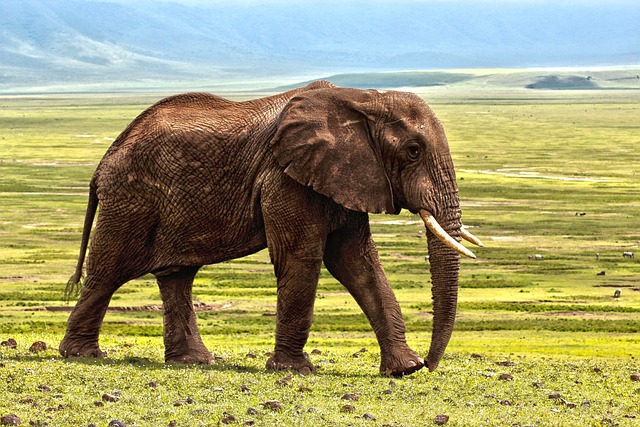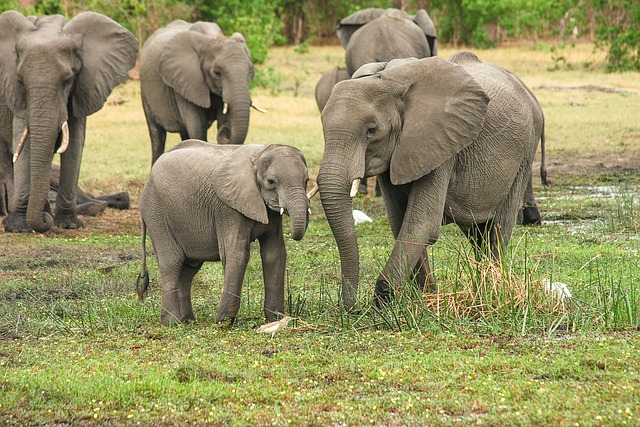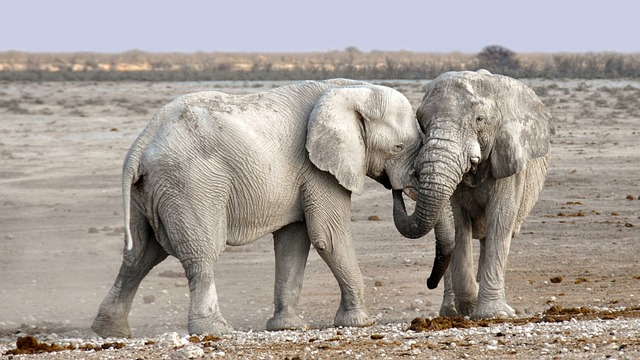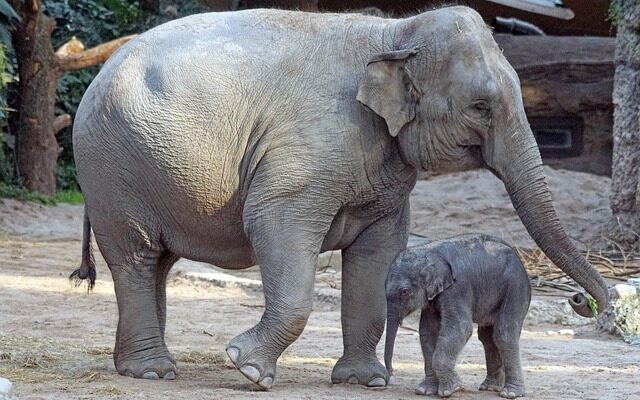Introduction:
Elephants, the largest land mammals on Earth, are divided into two distinct species: the African Elephant vs American Elephant. the African elephant (Loxodonta africana) and Asian elephant (Elephas maximus). While both share common characteristics, they exhibit key differences in terms of habitat, physical features, behavior, and conservation status. This article aims to provide a comprehensive comparative analysis of African and Asian elephants, shedding light on the uniqueness of each species.
I. Physical Characteristics:
A. Size and Build:
The African elephant holds the title for the largest land mammal. Male African elephants can weigh up to 14,000 pounds, stand around 10 to 13 feet tall at the shoulder, and have large, fan-shaped ears. In contrast, Asian elephants are slightly smaller, with males weighing around 11,000 pounds and standing 8.2 to 9.8 feet tall. Asian elephants are characterized by smaller, rounded ears compared to their African counterparts.
B. Trunk and Tusks:

Both elephants possess a prehensile trunk, a remarkable adaptation that serves multiple purposes, such as grasping objects, lifting food to the mouth, and even as a snorkel when swimming. However, African elephants’ trunks tend to be longer and have two finger-like projections at their tips, whereas Asian elephants typically have one.
Tusks, elongated incisor teeth, are present in both species, but African elephants’ tusks are generally larger. The tusks of Asian elephants, particularly in females, may be absent or much smaller.
II. Habitat and Range Of African elephant VS Asian elephant:
A. African Elephant:
African elephants are found in a wide range of habitats across the African continent, including savannas, forests, and grasslands. They are further divided into two subspecies: the African bush elephant, which inhabits a variety of ecosystems, and the African forest elephant, adapted to dense rainforests.
B. Asian Elephant:
These elephants inhabit a more diverse range of environments, including grasslands, tropical forests, and even mountainous regions. They are distributed across several countries in Asia, from India and Sri Lanka to Southeast Asian nations like Thailand and Indonesia.
III. Behavior and Social Structure:
A. African Elephant:
These are known for their complex social structures, typically organized into matriarchal family units. These units consist of related females and their offspring, led by the oldest and most experienced female, the matriarch. Male elephants tend to be more solitary but may form loose associations with other males.

B. Asian Elephant:
Teses also exhibit a social structure centered around family units, typically led by the oldest female. Male Asian elephants can be solitary or form small groups, especially during the breeding season. Unlike African elephants, Asian elephants are more likely to be found in smaller family groups.
IV. Conservation Status Of African elephant VS Asian elephant:
A. African Elephant:
These faces significant conservation challenges, primarily due to poaching for ivory, habitat loss, and human-wildlife conflict. Efforts to protect African elephants involve anti-poaching initiatives, community-based conservation, and international cooperation. The International Union for Conservation of Nature (IUCN) classifies the African elephant as vulnerable.
B. Asian Elephant:
These are also confronted with threats such as habitat fragmentation, human-wildlife conflict, and, to a lesser extent, poaching. Conservation measures include the establishment of protected areas, community engagement, and research to better understand and mitigate human-elephant conflict. The IUCN categorizes the Asian elephant as endangered.
Conclusion:
In conclusion, while those elephants share commonalities as part of the majestic elephant family, their differences are equally fascinating. From physical characteristics and habitat to behavior and conservation status, these two species offer unique perspectives on the challenges and wonders of the natural world. Understanding and appreciating the distinctions between African and Asian elephants are crucial for their conservation and the preservation of these magnificent creatures for generations to come.

The comparison between both reveals not only the biological diversity within the elephant family but also the intricate interplay between these majestic creatures and their respective environments. While both species face challenges, ranging from conservation issues to human-wildlife conflicts, understanding their unique characteristics and behaviors is vital for developing effective conservation strategies. By appreciating the nuances of both elephants, we can work towards ensuring the long-term survival and well-being of these remarkable giants on our planet.
V. Adaptations and Physical Features African elephant VS Asian elephant:
A. Ears:
One of the most noticeable distinctions between African and Asian elephants lies in the size and shape of their ears. African elephants boast larger ears that are often described as resembling the shape of the African continent. These large ears play a crucial role in thermoregulation, helping them cool down in the hot African climates. Asian elephants, on the other hand, have relatively smaller and more rounded ears. This difference in ear size is thought to be an adaptation to their habitats, with Asian elephants generally inhabiting forested areas with milder temperatures.
B. Humps:
These often exhibit a noticeable dip in their back, while Asian elephants typically have a more leveled back. The presence of a hump in African elephants is due to the larger size of their spine and shoulder bones. This structural difference may be related to the varied locomotion patterns and behaviors observed in these two species.
VI. Feeding Habits African elephant VS Asian elephant:
A. African Elephant:
These are primarily grazers, relying on a diet of grasses, leaves, bark, and fruits. Their large size and distinct jaw structure enable them to efficiently process coarse vegetation. During the dry season when water and food resources become scarce, These elephants may travel great distances in search of suitable forage.

B. Asian Elephant:
These are more versatile in their feeding habits, exhibiting both grazing and browsing behavior. Their diet includes a variety of vegetation such as grasses, leaves, fruits, and even agricultural crops. The trunk, with its fine motor control, allows Asian elephants to pick individual leaves and navigate through dense vegetation, making them well-adapted to the diverse environments they inhabit.
VII. Tusk Characteristics Of African elephant VS Asian elephant:
Tusks, prominent in both African and Asian elephants, exhibit variations between the two species.
A. African Elephant:
These tusks are generally larger and more curved compared to those of Asian elephants. The ivory from their tusks has unfortunately made them targets for poaching, contributing to the significant conservation challenges faced by these magnificent creatures.
B. Asian Elephant:
These may have smaller tusks, or in some cases, no tusks at all, particularly among females. This variation in tusk size makes them less vulnerable to ivory poaching compared to their African counterparts. However, the trade in ivory remains a concern for both species. Read more
FAQS:
Elephants are a keystone species – meaning that they play a pivotal role in structuring both plant and animal communities, contributing to biodiversity through seed dispersal and the creation of habitat mosaics.
Elephant, (family Elephantidae), is the largest living land animal, characterized by its long trunk (elongated upper lip and nose), columnar legs, and huge head with temporal glands and wide, flat ears. Elephants are grayish to brown in color, and their body hair is sparse and coarse.
14 elephant facts which are ele-phantastic
1 There are three species and two different ears. …
2 Elephants’ habitats are many and varied. …
3 They’re vegans. …
4 Elephant trunks are like noses with fingers. …
5 These grey giants love water and always wear “trunks”! …
6 Elephants use mud as sunscreen. …
7 Elephants’ teeth regrow.
more item
There are three species of elephant: African Savanna (Bush), African Forest, and Asian. The ears of African elephants are much larger than their cousins and are described as being shaped like the African continent, whereas the ears of Asian elephants are shaped like the Indian subcontinent.
12 Facts About Elephants You Might Not Know About
Elephants are the World’s Largest Land Animal. …
African Elephants and Asian Elephants are the Two Main Species. …
Asian Elephants are An Endangered Species. …
Elephants Communicate with Vibrations Through Their Feet. …
Elephant Family Units are Matriarchal.
more items
Elephant Love and Relationships
They can form lifelong friendships and will often only move in the same groups for their entire life. Elephants are also known to mourn the death of a loved one and have even been seen grieving over stillborn calves, or baby elephants who do not survive the first few months of life.
African elephants have rounded heads, while Asian elephants have twin-domed head, which means there’s a divot line running up the head. Finally, you can look at the tusks. Both male and female African elephants can have tusks, but only male Asian elephants can grow them.
On a very basic level, there are physical differences between Asian and African elephants. Perhaps the two most obvious are their ears and tusks. Asian elephants have smaller and rounder ears than their African cousins, whose ears are larger and often compared to the shape of the African continent.
Central African elephants are bigger and stronger than Asian ones. So they win. The North African elephants used in antiquity were a lot smaller than the Asian ones so they lost.





I am in fact pleased to read this web site posts which consists of
lots of valuable data, thanks for providing these kinds
of information.
Feel free to surf to my homepage :: Deposit 5000